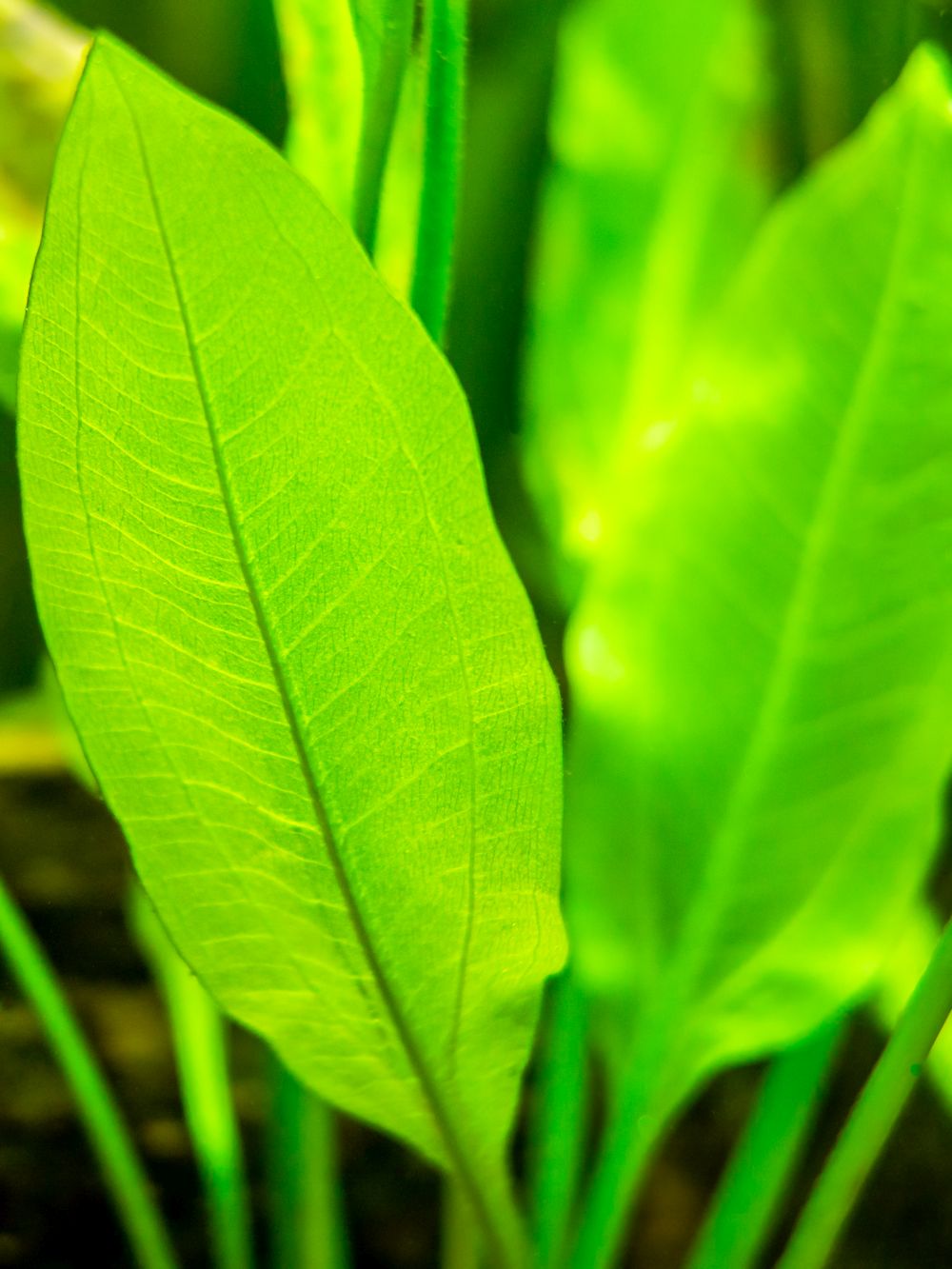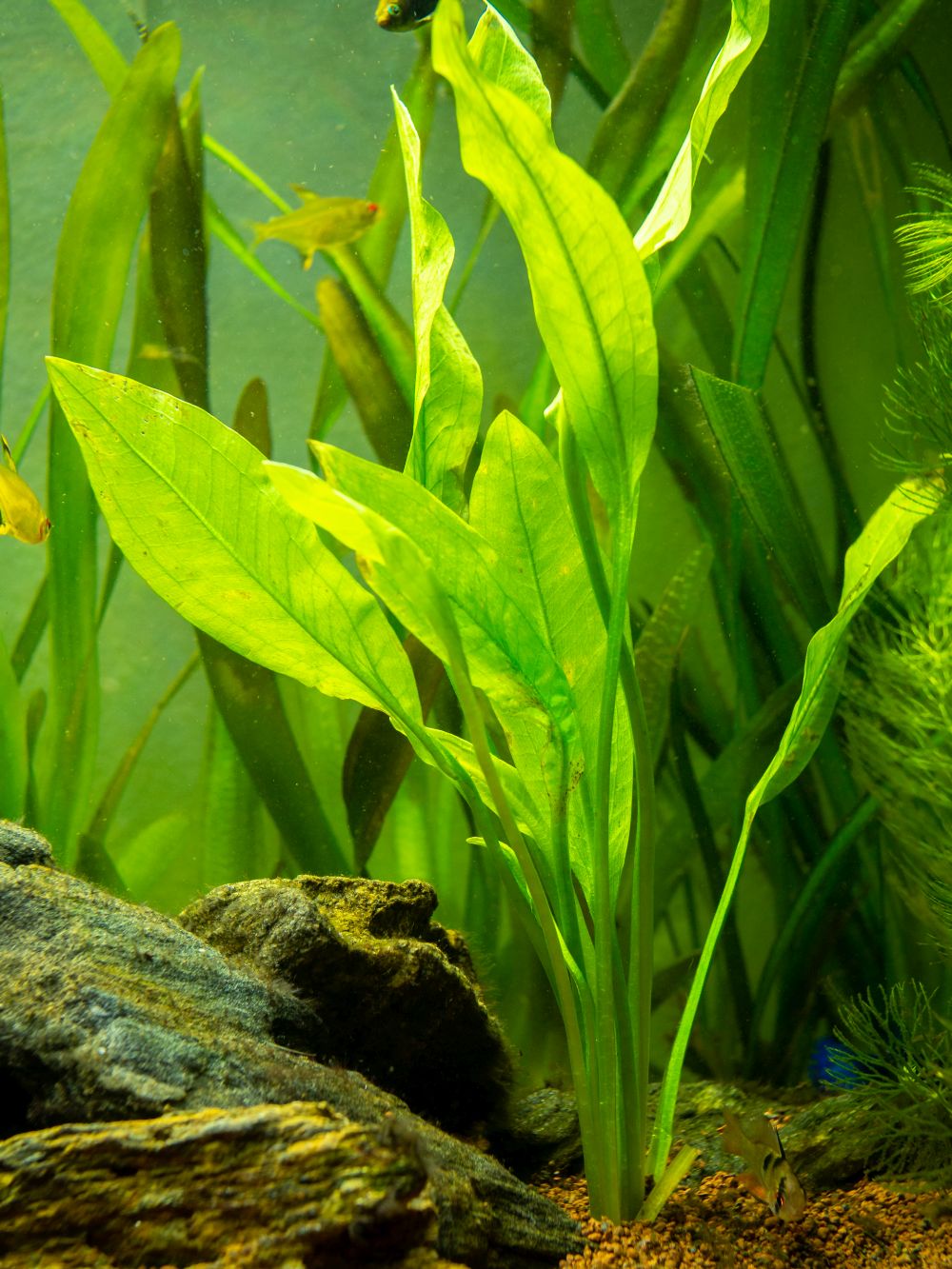Amazon Sword Care: How To Grow Amazon Sword In An Aquarium
The aquatic Amazon sword is a great freshwater plant to change the dynamics in the aquarium and make the fish feel right at home. Its green broad leaves and low maintenance requirements make it ideal for most fish tanks and marine life.
But growing an aquatic plant is not the same as growing a potted plant. The difference in the medium and care might be challenging if you have no prior experience with aquatic plants. This article walks you through the complex process of growing the Amazon sword plant and how to care for it. But first, let’s take a closer look at this stunning plant and find out what makes it so popular.
Amazon Sword at a Glance
Amazon sword (Echinodorus amazonicus) comes originally from South America, where it grows in abundance in the Amazon basin. In fact, the term Amazon sword refers to a variety of plants that have more or less the same characteristics. However, whatever plant you buy at the local aquarium or online, they all are easy to care for and follow almost the same process in planting and propagating them.
The leaves are the most prominent feature of the plant. That’s not surprising since the leaves shoot straight out of the rhizome. Each leaf grows to about 15 inches tall. And since it needs to be submerged underwater at all times, you’ll need to have a tank that caters to such a bushy plant.
The shape of the leaf is the reason the plant got that name. It starts narrow near the base, then broadens around the middle point before it tapers off toward the end. But unlike a sword, the leaves are dark green and grow at a moderate rate in healthy conditions.
With its short stem that doesn’t carry the weight of the leaves, the rhizomes play a major role in keeping the plant balanced in the water. The plant’s robust root system penetrates the substrate and spreads out far to keep the plant well anchored in the aquarium.
Amazon Sword Varieties
The term Amazon sword is an umbrella term that covers many freshwater aquatic plants that little in common. But they all share the same affinity for freshwater and the ability to grow and thrive in aquariums as long as you provide the right conditions. Here are some of these plants.
- Gigantea Sword: A native of Argentina and Brazil, this aquatic plant grows well under bright light and little to no current. It doesn’t take up much space and acts as a cover plant for small and shy fish in your aquarium. It doesn’t do well in poor light conditions or strong water motions.
- Pygmy Chain Sword: Another small plant that likes to spread wide but not up. Many of the fish that prefer to stay near the bottom of the tank will hide among the leaves of this plant. They have a high tolerance to different water temperatures and pollution. So they’re not prone to algae buildup as other aquatic plants on this list.
- Spade-Leaf Sword Plant: Unlike the Amazon sword, the leaves of this plant have nothing to do with swords. They’re round and flat and look more like a spade. They are sensitive to dirty water, and the leaves turn brown if you don’t clean the tank regularly.
- Red Melon Sword: This plant stands out in the aquarium with its red leaves. It creates a colorful background for the fish and other plants in the tank. However, it’s sensitive to the temperature of the water and requires lukewarm water at all times. If the temperature in the water drops 60 degrees Fahrenheit, the plant will become stressed and wither away.
How to Grow Amazon Sword
It takes a lot more to grow an aquatic plant than to sow the seeds and hope for the best. And while it’s a fully aquatic plant, the Amazon sword still needs soil in the tank to keep it rooted to the bottom of the aquarium. Here’s how to grow the Amazon sword in easy steps.
- Start by checking the pH of the water in the fish tank. These kits work much like a soil testing kit and provide an accurate reading of the pH levels in the tank. The water pH should be between 5.5 to 6.5. That’s the average pH of tap water.
- The Amazon sword is used to tropical conditions with temperatures ranging between 72 degrees to 82 degrees Fahrenheit. So test the water using a thermometer and adjust the temperature to fall between those two ranges.
- If the water is too cold in the tank, you can install a water heater. And in the summer, when the water temperature rises, you can replace the top side of the tank with a mesh screen. This will improve the airflow and help regulate the temperature of the water.
- Make sure the tank is placed near a window and that it gets between 10 to 12 hours of sunlight per day. Medium to high light is a prerequisite for the success of these tropical aquatic plants.
- Next, you need to add substrate (soil) to the bottom of the tank. You’ll need iron-rich soil in this case. Use a PVC pipe about 2 inches in diameter to transfer the substrate to the aquarium.
- Push the pipe all the way to the bottom and lean it at a 45 degrees angle. Then pour the substrate into the pipe and move the pipe along the bottom of the aquarium to spread the soil.
- Dig a hole deep enough to take the rhizome of the plant and push the Amazon sword down that hole. Cover the hole with soil and pack it lightly to keep the plant in place.
- Do the same for the rest of the plants making sure they’re arranged at the back of the aquarium.
Amazon Sword Care
And that was the easy part! Now to keep the plant happy and growing within control, you’ll need to keep a watchful eye on the thermostat, the aquarium filter, and how much light the plant the Amazon sword is getting every day. On top of that, you have to keep your pruning shears handy and examine the leaves regularly for any algae buildup or yellowing leaves. That might sound like a lot of work, but it takes that much to make the fish happy.
Tank Size and Substrate
The average Amazon sword grows to about 16 inches high, not to mention the runners that grow into new plants if left to their own devices. So even if you grow just one plant, you’ll need a 40-gallon tank to accommodate it along with the fish.
As for the substrate, you’ll need rich soil to nurture the plant. The soil should be dense to help keep the rhizomes of the plant anchored to the bottom of the aquarium. For best results, make sure you have about a 2.5-inch thick substrate in the tank. If the soil is too thin, the plant will float to the surface of the water.
Lighting
Sunlight is important for the health of the Amazon sword. The leaves of the plant absorb sunlight and turn it into vitamin D., So you need to expose the aquarium to anything between 10 to 12 hours of sunlight a day. If that’s not possible, you can use natural light as a viable alternative. Place the light at the top of the tank and keep it on for 12 hours a day. Light deprivation causes the leaves to crack and leads to the buildup of algae on the leaves of the plant.
Filter
With fish and other marine life in the tank, the water gets dirty pretty quickly. Although the Amazon sword has an excellent filtration system, it can get exhausted with the number of pollutants in such a limited space as your small fish tank. So make sure you have a powerful filter running at the aquarium that extracts and removes the pollutants from the water. That way, your plant will have healthy dark green leaves and grow without issues.
Water Type and Temperature
On average, you should water with hardness levels between 8 to 12 dGH. Most of the tap and well water fall somewhere between those levels. As for the water type, the Amazon sword grows well in different types of freshwater as long as they’re not highly acidic. It can tolerate slightly alkaline water with a pH as high as 7.5. So check the water in your tap to make sure its pH is between 5.5 and 7.5. You can adjust the water pH with commercial products to bring it up or down to this range.
The water temperature is another important factor. Luckily, you have more control over the temperature of the water than the pH or hardness levels. Try to keep the water in the aquarium at a steady 75 degrees Fahrenheit. In cold zones, a water heater will do this job efficiently.
Compatibility and Tankmates
Because of its large size, you will need to arrange the Amazon sword in the back of the tank so that it doesn’t cover the rest of the fish and plants. You can grow it successfully with companion plants such as water lettuce, pygmy chain sword, or spade-leaf sword plant.
Most fish that don’t eat the leaves of the Amazon sword will do well as tankmates for the aquatic plants. Ideal candidates are discus, platies, guppies, gouramis, mollies, zebra danios, plecos, and angelfish.
However, you shouldn’t grow the Amazon sword in a fish tank where species such as golden fish, Texas cichlids, oscar, or Jack Dempsey grow. They tend to rough up the leaves and tear them off at times.
Diseases
With the whole of the Amazon sword fully submerged underwater, it’s fully protected against pests and most of the diseases they carry. However, water as a medium has its own health hazards. One of those is algae. Algae grow in harsh light conditions and when the water is not clean. They usually grow on the leaves of the Amazon sword, and if you try to wipe them off, the leaves would crack. So grow some marine life species that feed on algae such as Amano shrimp, nerite snails, mystery snails, or red cherry shrimp.
The leaves of the Amazon sword are sensitive to changes in temperature and light conditions. Sometimes the leaves would start to die as soon as you place them in the aquarium. That’s normal. Just trim off the dead parts and keep monitoring the progress of the plant.
Poor soil can also cause the leaves to turn yellow. Use a liquid fertilizer rich in oil to bring the leaves back to life.

